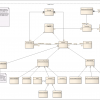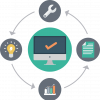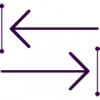Agile
Articles
 |
Top 10 StickyMinds Articles of 2017 With the rise of technology like AI and practices like DevOps, teams everywhere are looking for ways to speed up testing without sacrificing quality. The articles in 2017 reflect that, with the most popular topics being test automation, testing machine learning systems, next-generation exercises, and the future of software testing. If you're looking for cutting-edge testing techniques, check out this roundup. |
|
 |
Requirements Mapping Using Business Function Test Suites On this team, testers were overcommitted, avoidable defects were surfacing, and documentation was hard to find. Worse, trust and morale were low. Upgrading tools was out of the question, so the testers decided to take matters into their own hands and create incremental change themselves. Here's how a team added a new type of traceability to its requirement test case world. |
|
 |
The Value of Test-Driven Development when Writing Changeable Code Writing changeable code makes it easier and more cost-effective to add features to existing software. Writing changeable code doesn’t take longer, but it does require paying attention to certain things when building a system. It's important to have a good suite of unit tests that support refactoring code when needed, and test-driven development helps you create independently testable code. |
|
 |
DevSecOps: Incorporate Security into DevOps to Reduce Software Risk DevSecOps is a growing movement to incorporate security into DevOps practices in order to ensure flaws and weaknesses are exposed early on through monitoring, assessment, and analysis, so remediation can be implemented far earlier than traditional efforts. By failing fast with security testing, organizations reduce risk of a security incident and decrease the cost of rework. |
|
 |
Document Why as Well as What: Finding the Purpose of Your Software Code can express what we want to accomplish, but it’s a little more difficult to express why we’re doing something in the first place. The people who maintain code are often not those who originally wrote it, so documenting why helps set a context and gives clues as to what the author was thinking when they came up with a particular design, making developers' jobs easier. |
|
 |
4 Strategies for a Structured QA Process Being a software tester is no longer just about finding bugs. It is about continuous improvement, defining a clear test strategy, and going that extra mile to improve quality. Following a consistent, structured approach to QA will help you acquire more knowledge about the product you are testing, ask questions you otherwise may not have thought of, and become a true owner of quality. |
|
 |
Endgame Testing: Exploring Your Agile Product End to End The main goal of endgame testing is to test the system end to end from the user's perspective. This should ensure continuity between components developed by different teams, continuity in user experience, and successful integration of new features. Endgame testing will often identify gaps that are difficult to discover inside agile teams, including flows across the product. |
|
 |
Slim Down Your Test Plan Documentation Test plans are essential for communicating intent and requirements for testing efforts, but excessive documentation creates confusion—or just goes unread. Try the 5W2H method. The name comes from the seven questions you ask: why, what, where, when, who, how, and how much. That's all you need to provide valuable feedback and develop a sufficient plan of action. |
|
 |
Has Continuous Deployment Become a New Worst Practice? Software development has been moving toward progressively smaller and faster development cycles, and continuous integration and continuous deployment are compressing delivery times even further. But is this actually good for businesses or their users? Just because you can deploy to production quickly and frequently, should you? |
|
 |
Paying Off the Technical Debt in Your Agile Projects Just as you should not take out a financial loan without having a plan to pay it back, you should also have a plan when incurring technical debt. The most important thing is to have transparency—adequate tracking and visibility of the debt. Armed with the knowledge of these pending tasks, the team can devise a strategy for when and how to “pay off” technical debt. |











